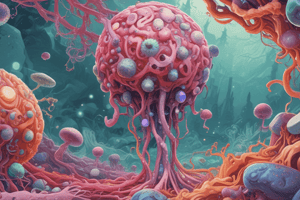Podcast
Questions and Answers
What defines a microorganism as a pathogen?
What defines a microorganism as a pathogen?
- Its tendency to cause disease in immunocompromised patients
- Its ability to cause disease in healthy persons with normal immune defenses (correct)
- Its origin from a source outside the body
- Its existence as part of the body's normal flora
Which type of pathogens rarely cause disease in immunocompetent people but can cause serious infections in immunocompromised patients?
Which type of pathogens rarely cause disease in immunocompetent people but can cause serious infections in immunocompromised patients?
- Exogenous agents
- Endogenous agents
- True pathogens
- Opportunistic pathogens (correct)
What is the 50% lethal dose (LD50) a measure of?
What is the 50% lethal dose (LD50) a measure of?
- The number of organisms needed to cause mild illness
- The number of organisms needed to kill half the hosts (correct)
- The number of organisms needed to infect the host
- The number of organisms needed to cause any form of disease
What are virulence factors responsible for?
What are virulence factors responsible for?
Which type of toxin can cause disease even in the absence of the microorganism itself?
Which type of toxin can cause disease even in the absence of the microorganism itself?
Which component of AB exotoxins is responsible for the toxic effects?
Which component of AB exotoxins is responsible for the toxic effects?
Which disease is caused by an exotoxin that prevents the release of inhibitory neurotransmitter glycine?
Which disease is caused by an exotoxin that prevents the release of inhibitory neurotransmitter glycine?
Which disease is caused by an exotoxin that triggers cAMP production and causes severe diarrhea and dehydration if left untreated?
Which disease is caused by an exotoxin that triggers cAMP production and causes severe diarrhea and dehydration if left untreated?
What type of exotoxins can make protein channels in the plasma membrane and kill various immune cells?
What type of exotoxins can make protein channels in the plasma membrane and kill various immune cells?
Which type of exotoxins stimulate a wide immune response by binding to major histocompatibility complex (MHC) class II molecules?
Which type of exotoxins stimulate a wide immune response by binding to major histocompatibility complex (MHC) class II molecules?
Which type of bacteria most commonly secretes exotoxins?
Which type of bacteria most commonly secretes exotoxins?
What is the primary function of the B subunit in AB exotoxins?
What is the primary function of the B subunit in AB exotoxins?
Which of the following refers to the ability of bacteria to spread to adjacent tissues through active or passive means?
Which of the following refers to the ability of bacteria to spread to adjacent tissues through active or passive means?
What are the critical determinants in overpowering the host during infectious diseases?
What are the critical determinants in overpowering the host during infectious diseases?
What is the term for specific toxins produced by bacteria, which can have local or systemic effects?
What is the term for specific toxins produced by bacteria, which can have local or systemic effects?
Which mechanism involves the production of capsules, biofilms, toxins, degradative enzymes, and resistance to antibiotics by bacteria?
Which mechanism involves the production of capsules, biofilms, toxins, degradative enzymes, and resistance to antibiotics by bacteria?
What are exoenzymes produced by pathogens that enable them to invade host cells and deeper tissues?
What are exoenzymes produced by pathogens that enable them to invade host cells and deeper tissues?
Which type of pathogens can cause disease through invasiveness, toxicity, and immunopathology?
Which type of pathogens can cause disease through invasiveness, toxicity, and immunopathology?
What is the term for the ability of pathogens to escape from the body's immune system?
What is the term for the ability of pathogens to escape from the body's immune system?
'Exoenzymes' are primarily involved in which bacterial function?
'Exoenzymes' are primarily involved in which bacterial function?
Flashcards are hidden until you start studying
Study Notes
- Staphylococcus aureus virulence factors include molecules synthesized by the bacteria or acquired from the environment
- Virulence factors enable the bacteria to cause damage to the host through various functions: colonization, immune escape, immunosuppression, cellular entry and exit, and nutrient extraction
- People get infectious diseases when the balance between the organism and the host shifts in favor of the organism
- Critical determinants in overpowering the host are the number of organisms and their virulence
- Pathogens can enter the body through various portals of entry, including mucous membranes, respiratory and gastro-intestinal tracts, genitourinary tract, conjunctiva, skin, and parenteral route
- Transmission of infectious diseases can occur through fecal-oral contact, wounds, burns, contact with animals or humans, and vectors
- Bacterial virulence mechanisms include the production of capsules, biofilms, toxins, degradative enzymes, and resistance to antibiotics
- Pathogens can cause disease through toxicity, invasiveness, and immunopathology
- Toxicity refers to specific toxins produced by bacteria, which can have local or systemic effects
- Invasiveness involves the ability of bacteria to spread to adjacent tissues through active or passive means, and the production of specific products and/or enzymes that promote spreading
- Exoenzymes are extracellular enzymes produced by pathogens that enable them to invade host cells and deeper tissues, and have a wide variety of targets
- Different classes of exoenzymes include glycohydrolases, nucleases, and proteases, each with specific targets
- Staphylococcus aureus is an example of a bacterium that causes systemic infections and is able to proliferate, disseminate, and destroy tissues, and produces various toxins and enzymes for virulence.
Studying That Suits You
Use AI to generate personalized quizzes and flashcards to suit your learning preferences.




